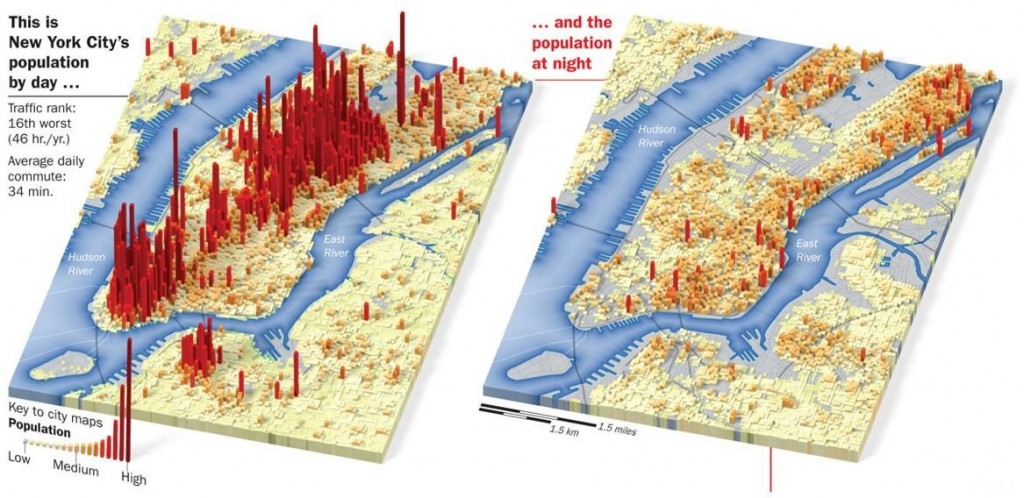The idea that work and home are in different places was institutionalized only recently in human history (and is still not reality everywhere). In early American history, most people were farmers. Both men and women worked at home. The technological advances that brought industrialization removed work from home. The factory was invented to house large machinery and many workers. Enter: wage work, the commute, and wives that “just” stayed home.
Today, the idea that work and home are separate places is largely taken for granted (though this may be reversing a bit) and is, in fact, institutionalized with zoning laws that specify whether space is to be used for work (and what kind), living, or both.
Dmitriy T.M. sent us a link to the images below. They compare the population of New York City and its boroughs the bottom two-thirds of Manhattan and parts of New Jersey, Brooklyn, and Queens during the day and night. It reveals nicely how we are organized so as to use different spaces differently.

—————————
Lisa Wade is a professor of sociology at Occidental College. You can follow her on Twitter and Facebook.

Comments 14
jfruh — August 14, 2009
Wow, considering that Manhattan has nightime population of almost 2 million, the number of people on the island during the day must be enormous!
WanderingOak — August 14, 2009
Did the image originate with Buzzfeed, or elsewhere? I would like to see a similar representation of the entire city, as well as some numbers to indicate what the bars of the graph mean.
Heather — August 14, 2009
Interesting. In light of the above, I wonder what it says about Houston, TX (the nation's 3rd largest city), that it has no zoning laws?
LGreenberg — August 16, 2009
This isn't New York City and it's boroughs! It's the lower two-thirds of Manhattan, part of New Jersey, part of Brooklyn and a little bit of Queens. There's DEFINITELY sociological significance to the fact that people think that this is a map of New York City.
Lisa Wade, PhD — August 16, 2009
LGreenberg,
Quite obvious when you point it out. :) Fixed.
Simoleon Sense » Blog Archive » Weekly Wisdom Roundup #41 (Links You Don’t Want To Miss) — August 16, 2009
[...] Infographic - The Invention And Institutionalization Of “Work” And “Home” - Via Sociological Images - The idea that work and home are in different places was [...]
karinova — August 17, 2009
Heh.
Love the correction on "New York City" ≠ Manhattan.
Now I don't have to give you the cheer my borough is famous for!
Kip — August 17, 2009
Where does everybody go during the night? THAT would make a better pair of images.
Kansai_Gal — August 18, 2009
I think it's interesting to consider that this is "only" the 16th worst traffic area in the US. I'd like to see a graph for say, Washington DC, where the population is almost entirely commuter.
What is the “Traditional” Age of Marriage? » Sociological Images — October 18, 2009
[...] But the 1950s was a really unusual time in American history. Elsewhere I’ve written about how the husband breadwinner/wife homemaker model is an American anomaly. The data below, put together by the New York Times, shows that the 1950s was an unusual time in [...]